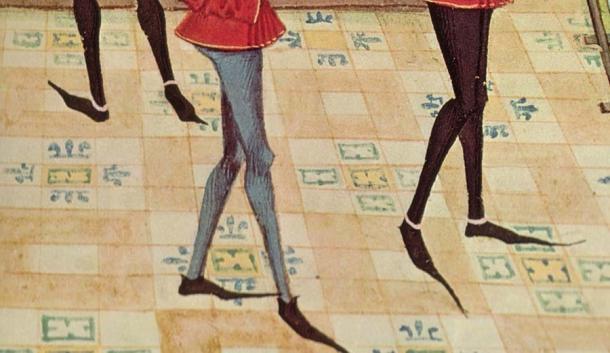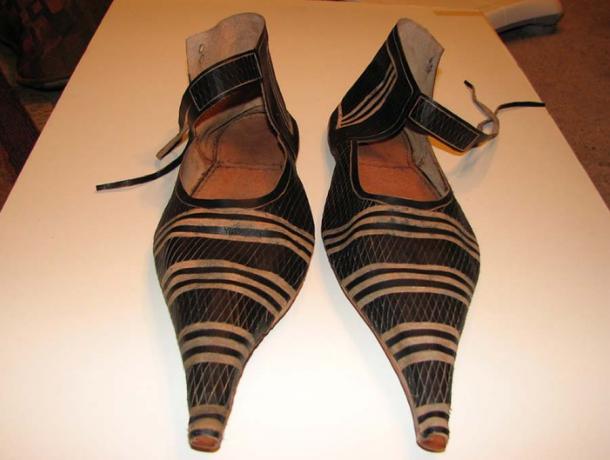Pointy shoes or winklepickers worn by the upper classes caused a spike in bunions in medieval Britain, a study has found. Close your eyes and picture the classic court jester. His jingly hat and wand aside, those long and elaborate pointed shoes have just become the focus of a new study: a rise in bunions in medieval Britain is now believed to have been caused by the “winklepicker”.
Suffering For Their Fashion
Known properly as “poulaines”, since the 1950s “winklepickers” have been standard footwear for classic British rock ‘n’ roll fans, but this new study shows how these long, thin and pointy shoes “unleashed a plague of bunions in Medieval Britain”. A team of Cambridge researchers has discovered that the iconic medieval shoe style that spiked in popularity in 14th century Britain caused an increase in foot deformities, as measured in almost 200 skeletons recovered from several of the city’s cemeteries.

Medieval winklepickers grew to extraordinary lengths (PKM / Public Domain )
The new study is published in the International Journal of Paleopathology and the team of Cambridge researchers believe a change in shoe style during the 14th century, “from a rounded toe to a lengthy, pointed tip, drove the rise in foot deformities.” The study shows that of the approximately 200 skeletons analyzed from the city’s cemeteries “27 per cent” of 14th and 15th century skeletons were “hobbled by longstanding hallux valgus,” better known as bunions, compared to “6 per cent” of those buried between the 11th and 13th centuries.
Nothing New About Bunions
“Hallux valgus” or “bunions” is a deformity in which the largest toe becomes angled outward towards the other toes, and a bony protrusion forms at its base on the inside of the foot. There is a high chance that if you live in the United Kingdom you will know this next bit, because chances are you know someone affected by bunions. But for everyone else, Britain has a “ Bunion Day ,” which this year is on Thursday 23 September.
The reason I said if you live in England you will know a sufferer of this is because there are around “14 million people” in the United Kingdom suffering from bunions. This includes “10 million women – 38% of women over 30,” according to the Bunion Day website.
The new University of Cambridge study claims that it was a change in shoe style in the 14th century that sparked the “poulaines” craze that was essentially to blame for the nation-wide outbreak of bunions. Co-author of the study, Dr Piers Mitchell from Cambridge’s Department of Archaeology, wrote that the 14th century brought “an abundance of new styles of dress and footwear in a wide range of fabrics and colors.” The long, pointed winklepickers were common among both adults and children alike and this led to a marked increase in bunions.
An Affliction For The Rich
The skeletons that were sampled in the study were taken from four burial sites around Cambridge: “a charitable hospital (now part of St John’s College); the grounds of a former Augustinian friary, where clergy and wealthy benefactors were buried; a local parish graveyard on what was the edge of town; and a rural burial site by a village almost four miles south of Cambridge,” according to the study.
An article about the paper in Daily Mail quotes co-author author, Dr Jenna Dittmar, saying that we tend to think of bunions as being only a modern problem, which they certainly are. But this work shows it was actually one of the more common conditions to have affected medieval adults. “But” she notes, “not all adults.”
The research reveals that “wealthier citizens and the clergy”, who wore the elaborate and faintly ridiculous shoes, were much more likely to suffer from bunions. While 3 percent of the rural cemetery showed signs of bunions and 10 percent of the parish graveyard holding poor people, “23 percent” of the wealthier people’s skeletons from the hospital site had bunions. Furthermore, “43 percent” of people buried in the friary had suffered from bunions.

Time for a Revival? (Jeff Martin & Godfrey von Rheinfels / CC BY-NC 2.0 )
Over time the “pointiness” of the winklepicker shoes even became so extreme that in the year 1463, King Edward IV passed a law limiting toe-point length to less than two inches in the City of London . This was because shoe size had become equated with one’s largesse and wealth in other areas, apparently leading to overcompensation so ridiculous it required legal intervention.
So you know what they say about a man’s socks, well make sure you apply that sentiment to his winklepickers as well.
Top image: Winklepickers are named for the supposed similarity to the tool used to extract winkles from their shells. Source: Rijksmuseum / CC0.
By Ashley Cowie
Related posts:
Views: 0
 RSS Feed
RSS Feed















 June 12th, 2021
June 12th, 2021  Awake Goy
Awake Goy  Posted in
Posted in  Tags:
Tags: 
















